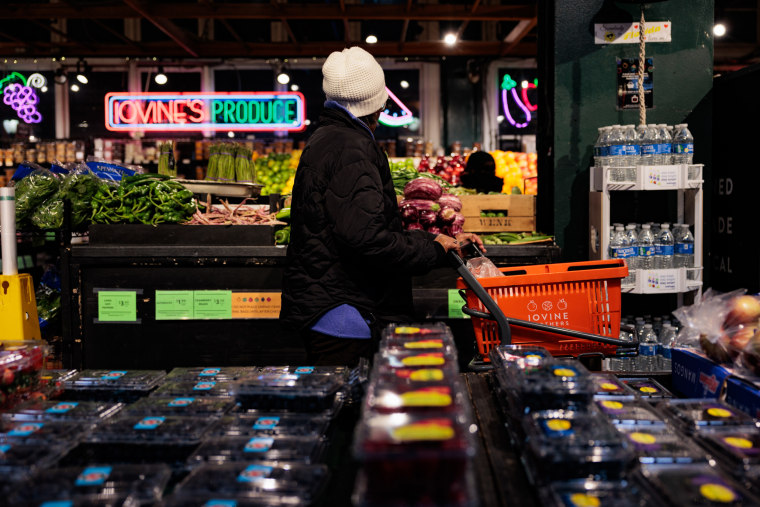What’s consumers’ relationship with the economy these days? It’s complicated.
As last year drew to a close, inflation appeared to be heading decisively downward, consumer confidence was shooting higher, and many Americans’ wages were finally outpacing price increases. In the early months of 2024, those trends have been a little harder to see, at least on the surface.
The annual inflation rate has bounced around north of 3% for months, the latest retail sales data came in soft, and wholesale prices took an unexpectedly higher leap. None of that has much rattled markets, where investors remain confident that the Federal Reserve will begin lowering interest rates this year, even if later than initially hoped — a long-awaited sign that the central bank’s crusade against inflation is finally coming to a victorious end.
But we aren’t there yet, and the Fed seems likely to reinforce that message when it meets again next week to plot its path forward. In the meantime, consumers continue to grumble about persistently high prices for everything from houses to burgers. Here’s what economists say the latest batch of indicators adds up to, and where it points in the weeks to come.
Somewhat higher gas prices
About two-thirds of the recent jump in wholesale inflation came from a surge in goods prices that federal economists largely traced to rising energy costs. That includes gasoline, which jumped 6.8% in the wholesale market last month.
Experts see this mainly as a normal seasonal trend. Demand for gasoline usually picks up as daylight saving time kicks in and the summer driving season nears. Prices at the pump are already rising modestly, with the average gallon of regular gas nearing $3.44 as of Friday, up 4 cents from a week ago — and that’s before pricier summer-blend gas has arrived at filling stations, AAA notes.
But energy markets are still dealing with some uncertainty, including from geopolitical factors like recent Ukrainian attacks on Russian refineries. On Thursday, the International Energy Agency revised its outlook for the year, predicting a slight supply deficit that could nudge up energy prices in coming months. Rising oil prices threaten to bleed into the cost of transporting goods, some experts said, which retailers could pass along to consumers.
“This could be a bit of a wild card,” said Ted Rossman, senior industry analyst at Bankrate. “If it all of a sudden costs 5 or 10% more to move goods around, that could contribute to inflation.”
With current gas prices still a few cents shy of their level a year ago, other analysts are more sanguine.
Pump prices are “very visible” to ordinary consumers, said Kayla Bruun, senior economist at Morning Consult, and could weigh a little on spending. “But as long as we have a strong underpinning of the labor market, it’s not necessarily something to be concerned about,” she said.
More cautious consumers
Still, new consumer sentiment figures released Friday showed shoppers’ views have leveled out after marching higher over the winter. “Consumers perceived few signals that the economy is currently improving or deteriorating,” University of Michigan researchers wrote of their March data.
In this climate, many people are getting more conservative with their spending than they were just a few years ago. Earlier in the pandemic recovery, many Americans’ bank accounts were flush with savings and stimulus money, and they flocked to reopened restaurants and fueled a boom in travel.
Some of that is still happening, but on a more measured level, experts said. Budget-conscious travelers have pulled back while more affluent ones continue to shell out as airlines chase premium-level dollars. Retail sales posted a 1.5% gain in February from the same month the year before, preliminary data showed Thursday, but they rose just 0.6% from January. “If you adjust for inflation, the sales were actually down a little bit,” Rossman said.
“A lot of people are saying, either with their words or even more so their actions, that maybe it’s not the best time to do a big home renovation or buy a new TV,” he said.
Americans’ wage growth is still trending above pre-pandemic rates, and unemployment continues to hold beneath 4%, despite ticking up last month. But persistently higher prices are eating into consumers’ income, even as inflation slows and some brands finally start to ease off their price hikes.
“People are spending for the most part because they have to, not because they necessarily want to,” Rossman added.
Known unknowns
Though the signals may look mixed at the moment, experts are broadly optimistic that the economy is on the right track.
What happens next is “going to depend a lot on the Federal Reserve’s interest rate path in the last six months of the year,” said Tuan Nguyen, U.S. economist at accounting and consulting firm RSM.
People are spending for the most part because they have to, not because they necessarily want to.
Ted Rossman, senior industry analyst at Bankrate
Already, though, RSM has updated its forecast for inflation to reach 2% as soon as midyear, more bullish than its previous estimate, based partly on “encouraging” retail numbers, Nguyen said. The Fed has pegged 2% as a target inflation rate it sees as supportive but not too restrictive of economic growth.
Rossman said this year’s economic data so far is “reflective of a slow-growth economy, but still a growing one.” That could boost the Fed’s confidence that it can keep rates “higher for longer” to tackle inflation without doing much collateral damage elsewhere, he said.
At the same time, Rossman noted that soaring credit card debt remains a key factor in how Americans will feel about the economy in the coming months.
“I think it does very much depend where one falls on that spectrum, as far as are you in the 44% of Americans with credit card debt?” he said. “If so, those rates are at record highs, and that’s a tough burden.”

